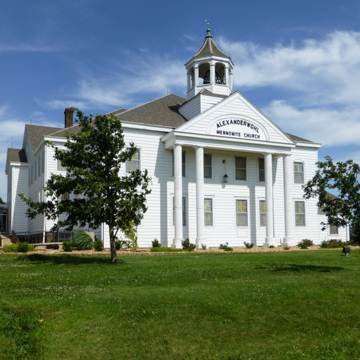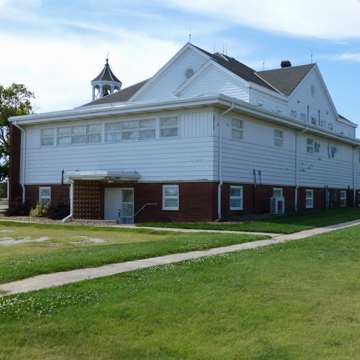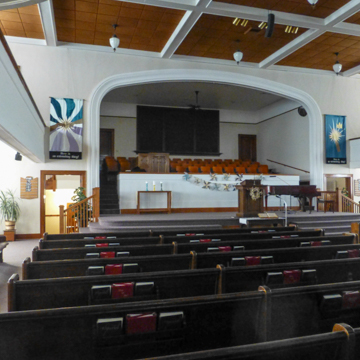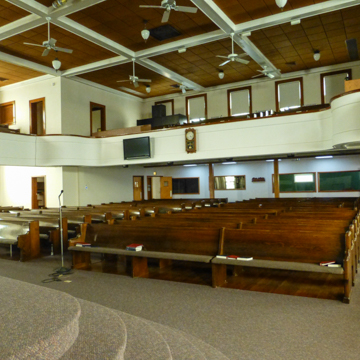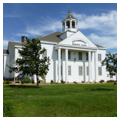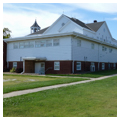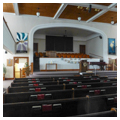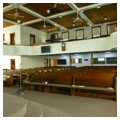The Alexanderwohl Mennonite Church in Goessel represents the culmination of a generations-long migratory trek of devout individuals in search of religious freedom. The church stands as a reminder of the contributions the Mennonites, who made their way to Kansas in the late nineteenth century, and their descendants have made to the state.
Mennonites trace their heritage to sixteenth-century Anabaptists but their identity was galvanized in the seventeenth century when they migrated to Prussia. In the face of ongoing prejudice and Prussia’s growing militarism, Mennonites moved again. In the 1820s, they were invited to settle in southern Russia, where they were promised exemption from military service and were given the right to operate their own schools and to self-govern. They named their village Alexanderwohl in honor of Czar Alexander, who welcomed the new settlers. This welcome was short lived; in 1870, after their special rights were revoked, the Mennonites began to look for a more hospitable environment in which to live. The western frontier of the United States promised religious liberty, offered similar agricultural opportunities to those with which they had become familiar in Russia, and land was readily available.
Working with Bernard Warkenton, a Mennonite who had moved to America in 1872, Reverend Jacob Buller arranged to purchase one thousand acres of land from the Atchison, Topeka and Santa Fe Railroad. He also arranged for every member of his congregation to move to the United States. The eight hundred people who made the trip represent the largest single group of migrants to enter the country. When the group arrived in Kansas, the railroad provided temporary housing for the immigrants until they were able to build houses on individual parcels of land, located in several places in south-central Kansas.
Buller led the group that settled in Marion County. After settlers had built their own residences, they relocated some of the temporary houses to the site of the Alexanderwohl Church, adapting them for use as worship space. The congregation grew rapidly—from 265 persons in 1874 to 467 in 1880. In 1886, the congregation was able to build a proper place of worship.
That structure was a traditional Mennonite design, consisting of a two-story rectangular wood frame, a hipped roof, and a single-story entry vestibule with a curved roof appended to the west elevation. The bulk of the building was filled with an auditorium-style worship space with balconies on three sides. Ever frugal, the Mennonites used wood from the temporary houses to build the permanent church.
Early in the twentieth century, vestibules smaller than the original but similar in design were added to the sides of the building. In 1928, the building underwent a renovation and expansion that substantially altered the church’s appearance. Most noticeably, the original building was lifted thirty-nine inches so that a basement could be dug under the building. Additional space was added to the west, and a grand, colonnaded, gabled portico topped by a bell tower was attached to the front of this expansion. In the early 1960s, the congregation erected two further additions that were used primarily as religious education spaces. These took the form of a long two-story wing stretching to the south, and a smaller mass added to the north.
Members of the congregation provided almost all of the labor involved in all phases of the construction. The building is straightforward and pragmatic, possessing a sense of coherence that reflects the simple dignity of Mennonite values and lifestyle. These qualities helped Mennonites as they adapted to their lives in a demanding environment. Their advances in agriculture, most significantly the cultivation of Turkey Red hard winter wheat, had a massive impact on the region. Mennonite settlers brought seed from their fields in Russia, which proved to be ideally suited to the harsh winters and drought conditions of Kansas. Bernard Warkenton, working with Mark Carleton from the U.S. Department of Agriculture, imported mass quantities of seed that had been developed to be more disease resistant. By 1919, thirty percent of the wheat grown in the United States and virtually all the wheat grown in Kansas descended from the strains brought by the Mennonites. It is because of their efforts that Kansas has come to be known as America’s breadbasket. Still an active church, this distinctive structure was built to serve Alexanderwohl’s spiritual needs but it also embodies the hard work, sacrifice, and shared communal values of the Mennonite community.
References
Goosen, Alvin. “The Alexanderwohl Church Building.” Mennonite Life29, no. 4 (December 1974): 88-91.
Schmidt, John W. “Turkey Wheat: A Mennonite Contribution to Great Plains Agriculture.” Mennonite Life29, no. 4 (December 1974): 67-70.
Haury, David. “Bernard Warkentin and the Kansas Mennonite Pioneers.” Mennonite Life29, no. 4 (December 1974): 70-75.














